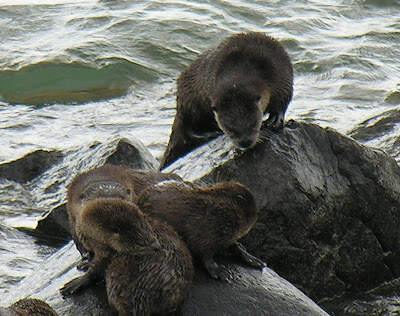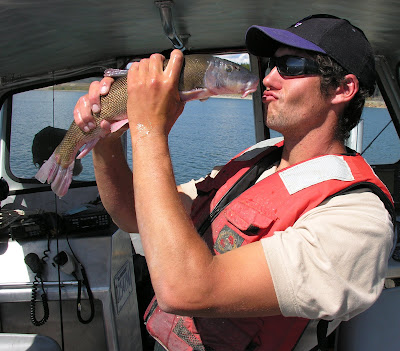A week later, nine thousand acres have been consumed, the southern half of the park is effectively closed, and Lake Village, where I live, is on the brink of evacuation. I write this post from my trailer bedroom, only a few miles north of the blaze. I, and all of my fisheries coworkers, are ad hoc (?) fire marshals; in the event of an evacuation, we’re to direct traffic and help coordinate the mass departure. Our office has been turned into the de facto fire-fighting headquarters – every morning two dozen firemen, or ‘hot shots,’ descend on our parking lot to discuss strategy. A small village of tents has sprung up on our front lawn, the dwellings of hot shots and the volunteers who have swarmed to Lake Village to help combat the Arnica Fire.
 Sunset at Mary Bay. Fires may be destructive, but they're sure photogenic.
Sunset at Mary Bay. Fires may be destructive, but they're sure photogenic.***
The National Parks Service has a complex and notorious history with fire management in Yellowstone National Park. For decades the official, misguided NPS policy, spearheaded by Smokey the Bear, was to quench every single park fire. But that policy of unilateral suppression proved catastrophic in 1988, when a gigantic inferno, fed by years of accumulated fuel load, threatened to destroy the entire park, and ultimately burned down 800,000 of acres.
Since then the park’s policy has been, for the most part, to let fires burn until they become a threat to people and property, and that's how this one has been treated. The main pocket of flames has already grown too large to douse, but helicopters have been dumping water on auxiliary fires for the last couple days, and, by spraying down our area with fire hoses, the hot shots hope to prevent the fire from spreading to the fisheries facilities.

The sun rises through a veil of smoke at Bridge Bay Marina.
The chaos, the volatile situation, and the disruption of our normal routine are thrilling, despite the (admittedly remote) prospect of calamity. As Erinn, another intern, pointed out: it’s like our first snow day since high school. And in fact, it's supposed to snow tonight, suppressing the fire for good. I might miss the entropy, just a little.

Forest fires are inherently unpredictable, and nobody really knows where this one is headed next, although every shift in the wind brings with it a new round of speculation. As of now the blaze is crawling south, away from my home, but that could rapidly change. And so we remain on standby, prepared to flee, and help others do the same, at a moment’s notice. We stay alert to any sensory stimuli that might indicate a change in our circumstances: the gauzy haze drifting across the southern sky, the distant thump of helicopter rotors, the acrid smoke in our lungs.
The chaos, the volatile situation, and the disruption of our normal routine are thrilling, despite the (admittedly remote) prospect of calamity. As Erinn, another intern, pointed out: it’s like our first snow day since high school. And in fact, it's supposed to snow tonight, suppressing the fire for good. I might miss the entropy, just a little.


A helicopter dumps water on the Arnica Fire, near the marina. Not to brag, but have you ever seen cooler photos outside National Geographic?
End.






